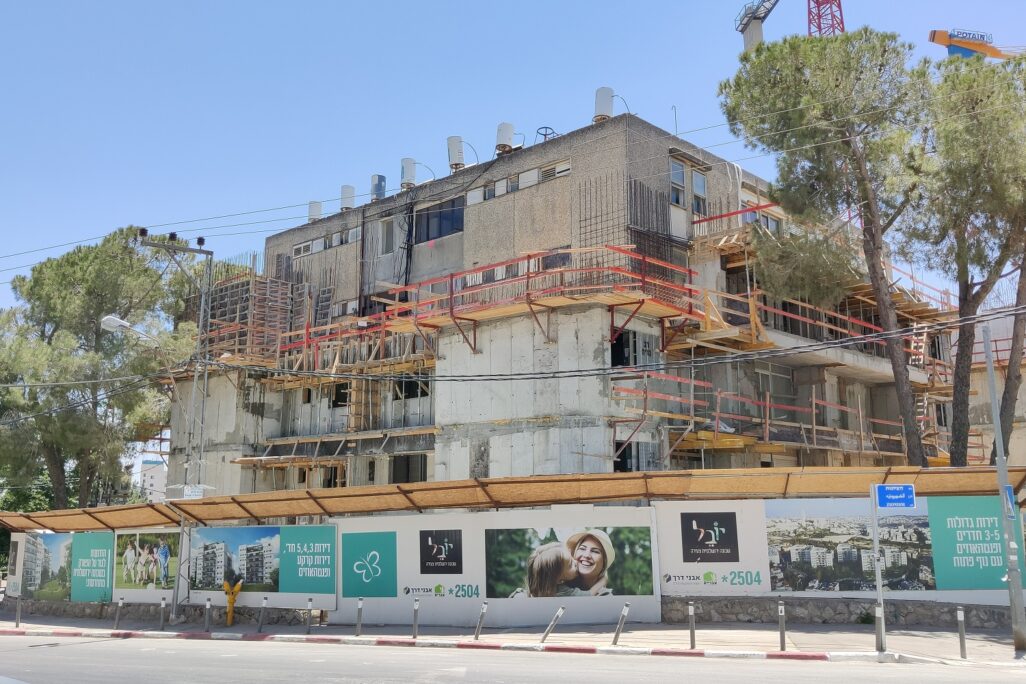
If there is one common denominator among the multitude of clauses presented by Housing Minister Yitzhak Goldknopf and Finance Minister Bezalel Smotrich in their 2024 housing plan, it is that all of them, without exception, continue to see the private market as the single solution to promote the ability of communities in Israel’s periphery and to expand the supply of affordable apartments. Past experience shows that this policy has yielded mixed results, but the government insists on sticking to it, even at a time when uncertainty in the market is at its peak.
The theory behind the plan is laid out in the section discussing the promotion of urban renewal. 462 million shekels ($128 million) out of a budget of two billion ($550 million) will be transferred to localities in the periphery so that they can promote urban renewal in their areas. This is not a new program, but a continuation of almost twenty years of trying to promote urban renewal in places where there is a risk of earthquakes and rocket fire by having local authorities absorb part of the expenses for the projects instead of the contractors.
This program has been promoted for several years due to the lack of viability of urban renewal in the periphery (or rather the excessive viability in the center of the country), but the plans have not taken off. So far, fewer than 1% of homes have been renewed under the program, because among other things, contractors prefer to renew homes in the center, even with the most generous incentives for renewal in the periphery.
These facts are known to the Ministries of Housing and Finance (which consciously works against the plan due to a claim of inefficiency), and yet almost a quarter of the total allocated budget is directed to an attempt to attract contractors to carry out urban renewal through subsidies.
In a similar way, you can also look at the 1.1 billion shekels ($300 million) from the budget that will go to subsidize development costs in land marketing tenders. On the face of it, this is a direct investment by the state in new construction processes that are supposed to make apartments cheaper by absorbing the development expenses imposed on the contractors. In the current case, it is intended to support localities where many tenders have failed in the last two years.
And yet, despite the difference in the investment method, the thinking behind the two main programs in the housing program remains the same: the role of the state is to serve as a supporting shoulder to the contractors in the hope that they will maintain a reasonable price level on the day the apartments are sold. This is also reflected in a relatively small supplementary clause, of only 50 million shekels ($14 million), which seeks to grant an even higher financing guarantee to contractors for risky projects
The third major clause in the plan, estimated at 300 million shekels ($83 million), which seeks to "chaperone" local authorities that issue many building permits, does not deviate from the same logic. Cities in the periphery have been struggling for decades to promote construction because of the high financing costs, low land value and a paucity of business areas with high income from property taxes.
The establishment of the property tax fund was supposed to alleviate this problem by reducing gaps between wealthier and poorer localities. But that was only a cover. The real goal of the fund and the current plan is to encourage new housing developments in the periphery, while ignoring the fundamental problems of these cities, which face difficulty in expansion and promoting a supply of apartments at an affordable price.
The State Comptroller's report from 2020 positively noted the direct investment in shelters and protection from rocket fire, promoted by the state in communities along the border with Gaza and in the north. Although only 18% of the buildings located near the Gaza border are protected, it is still a relative success story, because the shelters were built with direct funding, raising the standard of living of the residents via egalitarian investment.

Inspired by the success of the plan, a project to upgrade bomb shelters in the southern city of Ashkelon was announced in March 2022. However, this plan was soon shelved in favor of a plan to promote protection through urban renewal by transferring funds to contractors.
Now Smotrich and Goldknopf's housing plan seeks to make urban renewal and subsidizing contractors the only path to renewing the housing market after the current war. Israel is in a situation where more than 150,000 Israelis are displaced from their homes, entire cities are evacuated and badly damaged, and there is a steep rise in the number of unemployed and severe damage to the economic situation of many. In light of all this, an investment of two billion shekels, which is about 0.1% of the Israeli GDP, shows that the housing challenges of Israelis are very low on the priority list.
When you dive into the details and see that the bulk of the money will be transferred to the pockets of contractors in exchange for a promise on paper for the possibility of increasing the supply and lowering the prices of apartments, it seems that this is not just a matter of misplaced priorities, but of a completely ineffective method of operation. Certainly when there are over 60,000 new apartments in the housing market that have not yet been purchased, and it seems that housing supply is not the real problem, at least not in the near future.
The 60,000 residents who live up to three kilometers from the northern border will find it very difficult to return to their homes soon, and the issue of the security of their return raises many questions. Therefore, to continue to expect that private contractors will take risks for minor incentives in promoting projects in the area is completely disconnected from reality. Even "generous" incentive packages from the Finance Ministry can quickly become useless, similar to the public housing budgets.
The only plan that will guarantee investments in the current period, certainly when it comes to areas of national priority, must be backed by direct investment. It is clear to everyone today that it will not be possible to rehabilitate the destroyed kibbutzim through incentives alone, and that the restoration of trust to the residents will not be possible through years of watching tenders fail and housing prices rise.
Likewise, the thinking about other national programs must also change. We are in a situation of great uncertainty, against the backdrop of the possibility of the expansion of the war in the north and the uncertainty of its residents’ return. The peripheral communities in the north demand a clearer investment, with the return of the state as a constructive actor, as was the case in the early 1990’s with the wave of immigration from the Soviet Union. They deserve real support from the state to those who do not manage to purchase an apartment, by increasing the supply of public housing and promoting long-term rentals that are not at market prices.
This article was translated from Hebrew by Nancye Kochen.






